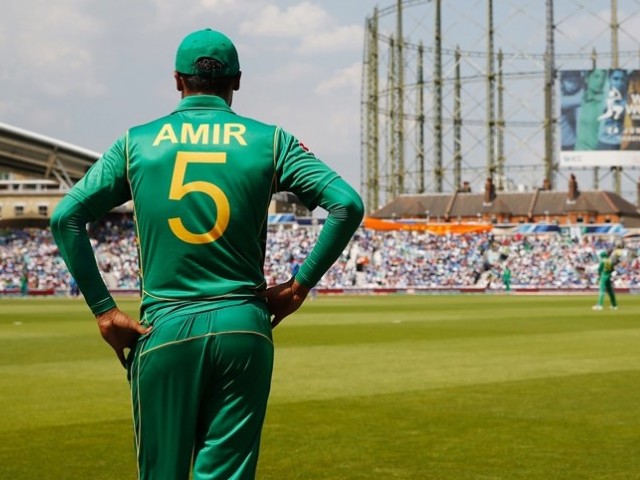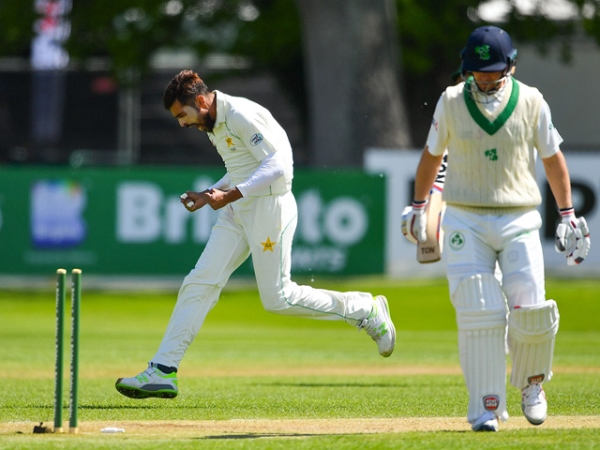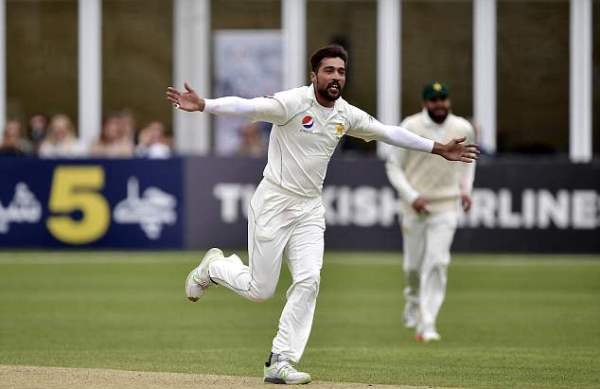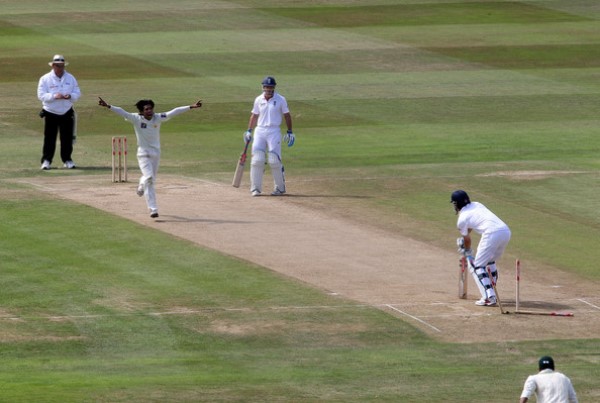
Since his return, Amir has played more Test matches and garnered even less wickets. PHOTO: AFP
Today’s Mohammad Amir is a shadow of his own past
The name has returned but the 18-year-old kid that could rip through the best batting line-ups in the world, has not.
Long silky hair blowing past his face, run up so smooth that there is not a single hint of hindrance and the ability to pitch the ball in the exact same spot, but make it move different ways at will. Who can ever forget the sight of an adolescent Mohammad Amir producing spells that reminded us of the legendary Wasim Akram?
With Pakistan’s victory over Ireland, Amir just completed a 100 Test wickets – a feat he would have accomplished long ago but life had other plans for him.
 13 May 2018; Mohammad Amir of Pakistan celebrates after bowling out William Porterfield of Ireland, right, during day three of the International Cricket Test match between Ireland and Pakistan at Malahide, in Co. Dublin. Photo: Getty
13 May 2018; Mohammad Amir of Pakistan celebrates after bowling out William Porterfield of Ireland, right, during day three of the International Cricket Test match between Ireland and Pakistan at Malahide, in Co. Dublin. Photo: GettyAlthough the Test wickets are only a 100, the journey behind them is more captivating than one could imagine.
“Magnificent bowling, goodness me that is as good as you can get”, said a jubilant Geoffrey Boycott on air as Amir bowled an absolute peach to remove Mitchell Johnson.
The only time you would hear an Australian commentator sing praises like that for a fast bowler is when either the bowler is Australian or he is unarguably one of the finest talents the world has ever seen.
Amir wasn’t only picking wickets for Pakistan; he was on his way to becoming a world sensation.
What happened next is no secret. Therefore, I don’t want to recall the dreaded incident in great detail. No-ball, allegations, bans and tears – these are all the buzz words that are enough to bring back the memories of Amir getting himself in the line of fire and getting banned from international cricket for five years, after admitting his involvement in spot-fixing.
 Pakistani cricketer Mohammad Aamer arrives from Doha, at the Allama Iqbal International airport in Lahore early February 8, 2011. Photo: AFP
Pakistani cricketer Mohammad Aamer arrives from Doha, at the Allama Iqbal International airport in Lahore early February 8, 2011. Photo: AFPOn July 13, 2016, Amir marked his return to Test cricket in the same place where he left us all in tears. His return was in a rush; the Pakistan Cricket Board (PCB) seemed to have woven a special path to get Amir back in the side. The rules were set differently for this young man, simply because he was that good. The desperation to have him back was at its peak.
Ever since Amir’s return, he has been a shadow of his former self. The name “Amir” has returned in Pakistan’s lineup but the 18-year-old kid that could rip through the best batting line-ups in the world, has not.
Barring a few glimpses of brilliance, Amir has struggled to make a mark that one would expect from the absolute best. His latest outing in the Test match against Ireland reflects where he currently stands. An injury prone Amir collected five wickets on a pitch tailor-made for fast bowling whereas his counterpart Mohammad Abbas collected nine. Amir was good enough but maybe not the best anymore.
 Mohammad Amir celebrates after taking the wicket of Gary Wilson of Ireland during the fourth day of the international test cricket match between Ireland and Pakistan on May 14, 2018 in Malahide, Ireland. Photo: Getty
Mohammad Amir celebrates after taking the wicket of Gary Wilson of Ireland during the fourth day of the international test cricket match between Ireland and Pakistan on May 14, 2018 in Malahide, Ireland. Photo: GettyMore often than not, the Amir today is a bowler that contains runs and waits for a wicket in return. As opposed to Amir of the past that couldn’t care less about leaking runs because he was in the middle of bowling spells that made the best in the business look ordinary.
Some say that five years away from cricket is enough to make one lose the art that he had mastered his entire life. Others are more technical and blame Amir for bowling too wide off the stumps, hence not able to get the in-swingers going. Some even believe that bowlers hunt in packs hence, without his partner-in-crime Mohammad Asif, Amir has struggled to pick early wickets because of lack of pressure created from the other end.
I am not entirely sure what caused Amir to lose some of his magic, therefore you may go with any school of thought that floats your boat. What I can say with more certainty is that Amir has been playing consistently in the side more so because of his reputation from the past rather than his current performances.
The same Amir that picked up a five-wicket haul at Melbourne against Australia in the first Test of 2009-2010 tour was wicket-less at Melbourne after his return in the tour of 2016 in the second Test match. A single example is by no means a barometer to explain the difference in Amir’s performance; it was merely a demonstration of the change in times for Amir. A further look at stats could reveal a fuller picture.
Amir bagged three five-wicket hauls in Test matches prior to his ban, all three of which were against England and Australia, while he has only managed one since his return against a struggling West Indian lineup. In terms of overall Test wickets, Amir had 51 wickets in 14 Test matches before the ban. Since his return, he has played more Test matches and garnered even less wickets. He currently stands at 49 wickets from 17 Test matches since his return.
 Alastair Cook of England is bowled out by Mohammad Amir of Pakistan during day four of the 2nd npower Test Match between England and Pakistan at Edgbaston on August 9, 2010 in Birmingham, England. Photo: Getty
Alastair Cook of England is bowled out by Mohammad Amir of Pakistan during day four of the 2nd npower Test Match between England and Pakistan at Edgbaston on August 9, 2010 in Birmingham, England. Photo: Getty Mohammad Amir of Pakistan celebrates the dismissal of Kraigg Brathwaite of West Indies during the 1st day of the 2nd Test match between West Indies and Pakistan at Kensington Oval, Bridgetown, Barbados, April 30, 2017. Photo: AFP
Mohammad Amir of Pakistan celebrates the dismissal of Kraigg Brathwaite of West Indies during the 1st day of the 2nd Test match between West Indies and Pakistan at Kensington Oval, Bridgetown, Barbados, April 30, 2017. Photo: AFPAlthough Amir hasn’t completely forgotten how to pick a wicket after returning to cricket, the stats do reveal that he hasn’t exactly been lethal either. I must mention, however, absolute sitters dropped off his bowling specifically made it seem like God wanted Amir to work twice as hard after his return.
The spell in the final of Champions Trophy showed what Amir could do once he is on song. When it mattered the most, he brought the mighty Indian top order to its knees but the question remains: where is this Amir lost for the rest of the year?
 Mohammad Amir of Pakistan celebrates after taking the wicket of India's Shikhar Dhawan during the ICC Champions Trophy Final match between India and Pakistan at The Kia Oval on June 18, 2017 in London, England. Photo: Getty
Mohammad Amir of Pakistan celebrates after taking the wicket of India's Shikhar Dhawan during the ICC Champions Trophy Final match between India and Pakistan at The Kia Oval on June 18, 2017 in London, England. Photo: Getty




COMMENTS (25)
Comments are moderated and generally will be posted if they are on-topic and not abusive.
For more information, please see our Comments FAQ